Comparative Analysis of Cutting Forces in CNC Milling of MDF: The Role of Tool Coatings, Cutting Speed, and Feed Per Tooth
Abstract
:1. Introduction
2. Materials and Methods
2.1. Machine
2.2. Tool
- TripleSi Coating: This coating consists of three layers. The first layer is titanium nitride, which has excellent adhesion properties to hard metal and is typically used as the final coating for conventional wood machining tools (golden layer). The second layer is aluminum titanium nitride, also tested alone as Hyperlox coating. This layer has an optimal ratio of hardness and toughness, high-temperature resistance up to 1200 °C, and when heated, forms a microscopic corundum layer that further protects the tool against abrasion, making it suitable for machining hard laminates. The top layer is rich in silicon nanostructures, providing superior surface hardness and protecting against oxidation during machining.
- Hyperlox Technology: Similar to the middle layer of the TripleSi coating, but with an improved coating process that promises 20 % longer edge life.
- Diamond-Like Carbon (DLC) Technology “CCDia Fiber Speed”: This technology is based on a tetrahedral amorphous structure with more than 80 % sp3 concentration. The amorphous structure gives the DLC coating a hardness very close to natural diamond (up to 10,000 HV, Vickers Hardness) and an extremely low friction coefficient (<0.1).
2.3. Sample and Cutting Conditions
2.4. Measuring Equipment
2.5. Analysis of the Issue
3. Results
3.1. Feed Per Tooth Effect
3.2. Cutting Speed Effect
3.3. Tool Coating Effect
4. Discussion
4.1. Feed Per Tooth Effect
4.2. Cutting Speed Effect
4.3. Tool Coating Effect
4.4. Conventional and Climb Milling Effect
4.5. Practical Implications
4.6. Future Work
5. Conclusions
- Cutting speed effect: The cutting speed showed a non-significant impact on cutting forces, allowing flexibility in speed adjustments without negatively affecting milling performance. The optimal cutting speed observed for minimizing cutting forces across different coatings was found to be 10 m/s, where certain coatings (notably reference and TripleSi) exhibited a reduction in cutting forces.
- Feed per tooth effect: The feed per tooth significantly influenced cutting forces, with higher feed speeds resulting in greater cutting forces. To optimize cutting efficiency and tool life, a feed per tooth value of 0.1 mm is recommended, as it consistently resulted in lower cutting forces across all tested coatings.
- Tool coatings: Among the tested coatings, the lapped surface and TripleSi coating consistently demonstrated the lowest cutting forces, making them the most efficient choices for MDF milling. In contrast, the DLC coating resulted in the highest cutting forces, indicating it may not be suitable for MDF milling under the tested conditions.While the lapped surface provides low cutting forces, its time-consuming production process and lack of hardness improvement could lead to a shorter tool life. Therefore, the tool with the TripleSi coating is a more suitable choice, balancing efficiency and durability. Thus, the TripleSi coating is recommended for optimal performance due to its effective combination of low cutting forces and extended tool life.
- In summary, under our specific machining conditions, the optimal parameters for CNC milling of MDF to minimize cutting forces are a cutting speed of 10 m/s, a feed per tooth value of 0.1 mm, and the use of tools with TripleSi coating. These findings can guide the selection of appropriate machining parameters and tool coatings in real operating conditions. By reducing cutting forces, these parameters help minimize tool wear, lower energy consumption, and improve surface quality. This can lead to more cost-effective and environmentally friendly manufacturing processes, as lower cutting forces generally translate to lower energy consumption.
Author Contributions
Funding
Institutional Review Board Statement
Informed Consent Statement
Data Availability Statement
Conflicts of Interest
References
- Petre, I.M.; Găvruş, C. Influence of the Cutting Force upon Machining Process Efficiency. Mater. Today Proc. 2023, 72, 586–593. [Google Scholar] [CrossRef]
- Hernández-González, L.W.; Curra-Sosa, D.A.; Pérez-Rodríguez, R.; Zambrano-Robledo, P.D. Modeling Cutting Forces in High-Speed Turning Using Artificial Neural Networks. TecnoLógicas 2021, 24, 43–61. [Google Scholar] [CrossRef]
- Chatterjee, K.; Zhang, J.; Dixit, U.S. Data-driven Framework for the Prediction of Cutting Force in Turning. IET Collab. Intell. Manuf. 2020, 2, 87–95. [Google Scholar] [CrossRef]
- Velchev, S.; Kolev, I.; Ivanov, K.; Gechevski, S. Empirical Models for Specific Energy Consumption and Optimization of Cutting Parameters for Minimizing Energy Consumption during Turning. J. Clean. Prod. 2014, 80, 139–149. [Google Scholar] [CrossRef]
- Stephenson, D.A.; Agapiou, J.S. Metal Cutting Theory and Practice; CRC Press: Boca Raton, FL, USA, 2018; ISBN 1-315-37311-4. [Google Scholar]
- Venkatesan, K.; Manivannan, K.; Devendiran, S.; Mathew, A.T.; Ghazaly, N.M.; Benny, S.N. Study of Forces, Surface Finish and Chip Morphology on Machining of Inconel 825. Procedia Manuf. 2019, 30, 611–618. [Google Scholar] [CrossRef]
- Wyeth, D.J.; Goli, G.; Atkins, A.G. Fracture Toughness, Chip Types and the Mechanics of Cutting Wood. A Review COST Action E35 2004–2008: Wood Machining–Micromechanics and Fracture. Holzforschung 2009, 63, 2. [Google Scholar] [CrossRef]
- Guo, X.; Li, R.; Cao, P.; Ekevad, M.; Cristóvão, L.; Marklund, B.; Grönlund, A. Effect of Average Chip Thickness and Cutting Speed on Cutting Forces and Surface Roughness during Peripheral up Milling of Wood Flour/Polyvinyl Chloride Composite. Wood Res 2015, 60, 147–156. [Google Scholar]
- Marchal, R.; Mothe, F.; Denaud, L.-E.; Thibaut, B.; Bleron, L. Cutting Forces in Wood Machining–Basics and Applications in Industrial Processes. A Review COST Action E35 2004–2008: Wood Machining–Micromechanics and Fracture. Holzforschung 2009, 63, 2. [Google Scholar] [CrossRef]
- Franz, N.C. An Analysis of Chip Formation in Wood Machining; University of Michigan: Ann Arbor, MI, USA, 1958. [Google Scholar]
- McKenzie, W.M. Fundamental Aspects of the Wood Cutting Process; University of Michigan: Ann Arbor, MI, USA, 1961; ISBN 9798658308999. [Google Scholar]
- Eyma, F.; Méausoone, P.-J.; Larricq, P.; Marchal, R. Utilization of a Dynamometric Pendulum to Estimate Cutting Forces Involved during Routing. Comparison with Actual Calculated Values. Ann. For. Sci. 2005, 62, 441–447. [Google Scholar] [CrossRef]
- Pahlitzsch, G.; Dziobek, K. Untersuchungen Über Das Bandschleifen von Holz Mit Geradliniger Schnittbewegung. Holz Als Roh-Und Werkst. 1959, 17, 121–134. [Google Scholar] [CrossRef]
- Porankiewicz, B.; Bermudez, E.J.; Tanaka, C. Cutting Forces by Peripheral Cutting of Low Density Wood Species. BioResources 2007, 2, 671–681. [Google Scholar] [CrossRef]
- Axelsson, B.O.M.; Lundberg, Å.S.; Grönlund, J.A. Studies of the Main Cutting Force at and near a Cutting Edge. Holz. Als. Roh- Und Werkst. 1993, 51, 43–48. [Google Scholar] [CrossRef]
- Porankiewicz, B.; Axelsson, B.; Grönlund, A.; Marklund, B. Main and Normal Cutting Forces by Machining Wood of Pinus Sylvestris. BioResources 2011, 6, 27. [Google Scholar] [CrossRef]
- Moradpour, P.; Scholz, F.; Doosthoseini, K.; Tarmian, A. Measurement of Wood Cutting Forces during Bandsawing Using Piezoelectric Dynamometer. Drv. Ind. 2016, 67, 79–84. [Google Scholar] [CrossRef]
- Sheikh-Ahmad, J.Y.; Morita, T. Tool Coatings for Wood Machining: Problems and Prospects. For. Prod. J. 2002, 52, 43. [Google Scholar]
- Heisel, U.; Martynenko, S.; Schneider, M. Influence of Chip Space Filling on Cutting Forces in High-Speed Milling of Wood and Derived Timber Products. In Proceedings of the Third International Symposium on Wood Machining, Lausanne, Switzerland, 21–23 May 2007; pp. 51–59. [Google Scholar]
- Hlásková, L.; Kopecký, Z.; Novák, V. Influence of Wood Modification on Cutting Force, Specific Cutting Resistance and Fracture Parameters during the Sawing Process Using Circular Sawing Machine. Eur. J. Wood Prod. 2020, 78, 1173–1182. [Google Scholar] [CrossRef]
- Hlásková, L.; Procházka, J.; Novák, V.; Čermák, P.; Kopecký, Z. Interaction between Thermal Modification Temperature of Spruce Wood and the Cutting and Fracture Parameters. Materials 2021, 14, 6218. [Google Scholar] [CrossRef]
- Kopecký, Z.; Hlásková, L.; Orlowski, K. An innovative approach to prediction energetic effects of wood cutting process with circular-saw blades. Wood Res. 2010, 9, 827–834. [Google Scholar]
- Kopecký, Z.; Hlásková, L.; Solař, A.; Nesázal, P. Cutting forces in quasi-orthogonal cnc milling. Wood Res. 2019, 64, 12. [Google Scholar] [CrossRef]
- Koch, P. Wood Machining Processes. Wood Mach. Process. 1964, 9, 530. [Google Scholar]
- Kminiak, R.; Kubs, J. Cutting Power during Cross-Cutting of Selected Wood Species with a Circular Saw. Bioresources 2016, 11, 10528–10539. [Google Scholar] [CrossRef]
- Hlásková, L.; Orlowski, K.A.; Kopecký, Z.; Jedinák, M. Sawing Processes as a Way of Determining Fracture Toughness and Shear Yield Stresses of Wood. BioResources 2015, 10, 5381–5394. [Google Scholar] [CrossRef]
- Orlowski, K.; Ochrymiuk, T. A Newly-Developed Model for Predicting Cutting Power during Wood Sawing with Circular Saw Blades. Maderas Cienc. Tecnol. 2017, 19, 149–162. [Google Scholar] [CrossRef]
- Orlowski, K.A.; Ochrymiuk, T.; Hlaskova, L.; Chuchala, D.; Kopecky, Z. Revisiting the Estimation of Cutting Power with Different Energetic Methods While Sawing Soft and Hard Woods on the Circular Sawing Machine: A Central European Case. Wood Sci. Technol. 2020, 54, 457–477. [Google Scholar] [CrossRef]
- Aguilera, A. Cutting Energy and Surface Roughness in Medium Density Fiberboard Rip Sawing. Eur. J. Wood Wood Prod. 2011, 69, 11–18. [Google Scholar] [CrossRef]
- Cristóvão, L.; Broman, O.; Grönlund, A.; Ekevad, M.; Sitoe, R. Main Cutting Force Models for Two Species of Tropical Wood. Wood Mater. Sci. Eng. 2012, 7, 143–149. [Google Scholar] [CrossRef]
- Vazquez-Cooz, I.; Meyer, R.W. Cutting Forces for Tension and Normal Wood of Maple. For. Prod. J. 2006, 56, 4. [Google Scholar]
- Chen, Y.; Wang, J.; Chen, M. Enhancing the Machining Performance by Cutting Tool Surface Modifications: A Focused Review. Mach. Sci. Technol. 2019, 23, 477–509. [Google Scholar] [CrossRef]
- Kumar, R.; Rezapourian, M.; Rahmani, R.; Maurya, H.S.; Kamboj, N.; Hussainova, I. Bioinspired and Multifunctional Tribological Materials for Sliding, Erosive, Machining, and Energy-Absorbing Conditions: A Review. Biomimetics 2024, 9, 209. [Google Scholar] [CrossRef]
- Wei, H.; Chen, G.; Chen, Z.; Yu, Z.; Huang, J. Progress on Bionic Textured Cutting Tools: A Review and Prospects. J. Bionic. Eng. 2024, 21, 19–55. [Google Scholar] [CrossRef]
- Huang, Q.; Shi, X.; Xue, Y.; Zhang, K.; Wu, C. Optimization of Bionic Textured Parameter to Improve the Tribological Performance of AISI 4140 Self-Lubricating Composite through Response Surface Methodology. Tribol. Int. 2021, 161, 107104. [Google Scholar] [CrossRef]
- Rech, J. Influence of Cutting Tool Coatings on the Tribological Phenomena at the Tool–Chip Interface in Orthogonal Dry Turning. Surf. Coat. Technol. 2006, 200, 5132–5139. [Google Scholar] [CrossRef]
- Kusiak, A.; Battaglia, J.-L.; Rech, J. Tool Coatings Influence on the Heat Transfer in the Tool during Machining. Surf. Coat. Technol. 2005, 195, 29–40. [Google Scholar] [CrossRef]
- Czarniak, P.; Szymanowski, K.; Kucharska, B.; Krawczyńska, A.; Sobiecki, J.R.; Kubacki, J.; Panjan, P. Modification of Tools for Wood Based Materials Machining with TiAlN/a-CN Coating. Mater. Sci. Eng. B 2020, 257, 114540. [Google Scholar] [CrossRef]
- Ratajski, J.; Gulbiński, W.; Staśkiewicz, J.; Walkowicz, J.; Myśliński, P.; Czyżniewski, A.; Suszko, T.; Gilewicz, A.; Warcholiński, B. Hard Coatings for Woodworking Tools—A Review. J. Achiev. Mater. Manuf. Eng. 2009, 37, 668–674. [Google Scholar]
- Swisher, M.M. A Molecular Dynamics Study of the Tribological Properties of Diamond like Carbon. Ph.D. Thesis, Massachusetts Institute of Technology, Cambridge, MA, USA, 2020. [Google Scholar]
- Haubner, R.; Lessiak, M.; Pitonak, R.; Köpf, A.; Weissenbacher, R. Evolution of Conventional Hard Coatings for Its Use on Cutting Tools. Int. J. Refract. Met. Hard Mater. 2017, 62, 210–218. [Google Scholar] [CrossRef]
- Tabakov, V.P.; Vereschaka, A.S.; Vereschaka, A.A. Multilayer Composition Coatings for Cutting Tools: Formation and Performance Properties. Mech. Ind. 2017, 18, 706. [Google Scholar] [CrossRef]
- Warcholinski, B.; Gilewicz, A. Multilayer Coatings on Tools for Woodworking. Wear 2011, 271, 2812–2820. [Google Scholar] [CrossRef]
- Gilewicz, A.; Warcholinski, B.; Myslinski, P.; Szymanski, W. Anti-Wear Multilayer Coatings Based on Chromium Nitride for Wood Machining Tools. Wear 2010, 270, 32–38. [Google Scholar] [CrossRef]
- Pancielejko, M.; Czyżniewski, A.; Gilewicz, A.; Zavaleyev, V.; Szymański, W. The Cutting Properties and Wear of the Knives with DLC and W-DLC Coatings, Deposited by PVD Methods, Applied for Wood and Wood-Based Materials Machining. Arch. Mater. Sci. Eng. 2012, 58, 235–244. [Google Scholar]
- Endler, I.; Bartsch, K.; Leonhardt, A.; Scheibe, H.-J.; Ziegele, H.; Fuchs, I.; Raatz, C. Preparation and Wear Behaviour of Woodworking Tools Coated with Superhard Layers. Diam. Relat. Mater. 1999, 8, 834–839. [Google Scholar] [CrossRef]
- Vetter, J. 60 Years of DLC Coatings: Historical Highlights and Technical Review of Cathodic Arc Processes to Synthesize Various DLC Types, and Their Evolution for Industrial Applications. Surf. Coat. Technol. 2014, 257, 213–240. [Google Scholar] [CrossRef]
- Mikuláš, S.; Richard, K.; Ján, Š.; Andrej, J. Delenie a Obrábanie Dreva: Vysokoškolská Učebnica; Technická Univerzita vo Zvolene: Zvolen, Slovakia, 2017; ISBN 978-80-228-2845-1. [Google Scholar]
- Wenyong, S.; Yan, M.; Chunmei, Y. Research on Cutting Force and Cutting Vibration in Milling of PE WPC. Int. J. Multimed. Ubiquitous Eng. 2016, 11, 103–110. [Google Scholar] [CrossRef]
- Sagar, C.K.; Kumar, T.; Priyadarshini, A.; Gupta, A.K. Prediction and Optimization of Machining Forces Using Oxley’s Predictive Theory and RSM Approach during Machining of WHAs. Def. Technol. 2019, 15, 923–935. [Google Scholar] [CrossRef]
- Aykut, Ş.; Bagci, E.; Kentli, A.; Yazıcıoğlu, O. Experimental Observation of Tool Wear, Cutting Forces and Chip Morphology in Face Milling of Cobalt Based Super-Alloy with Physical Vapour Deposition Coated and Uncoated Tool. Mater. Des. 2007, 28, 1880–1888. [Google Scholar] [CrossRef]

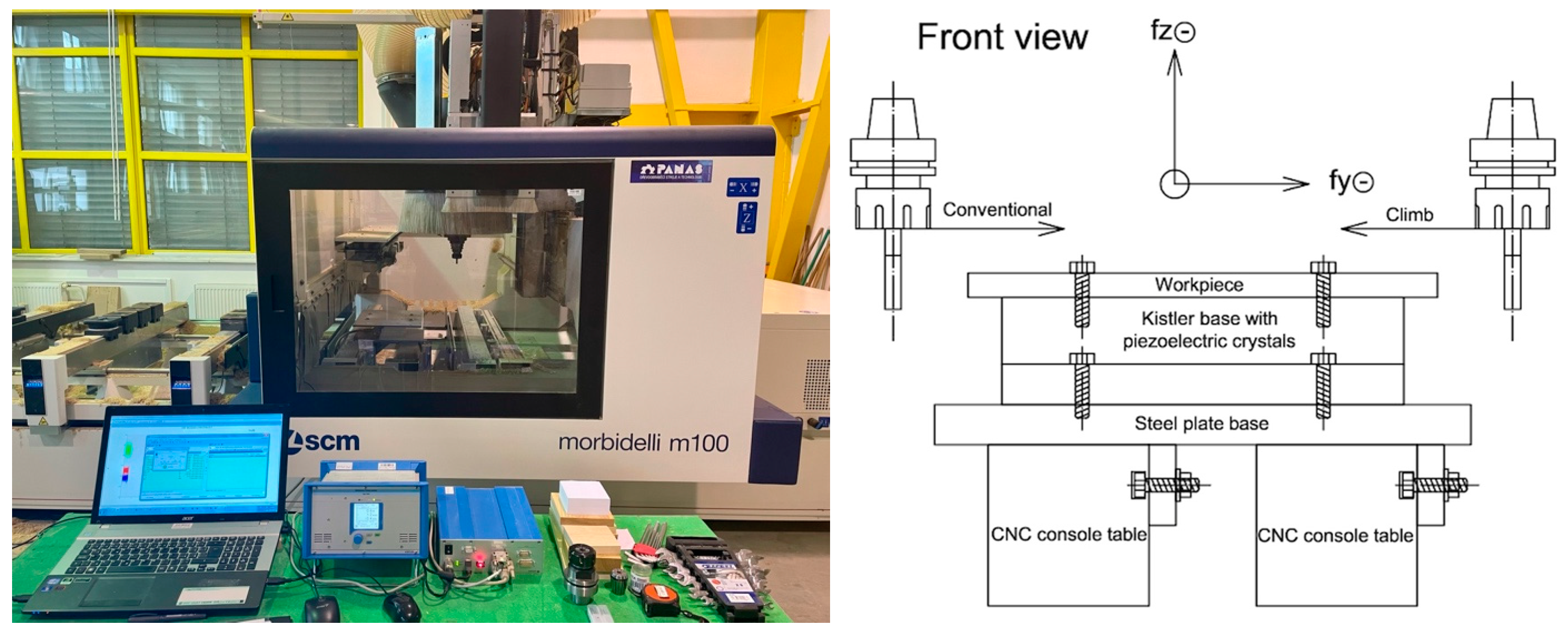
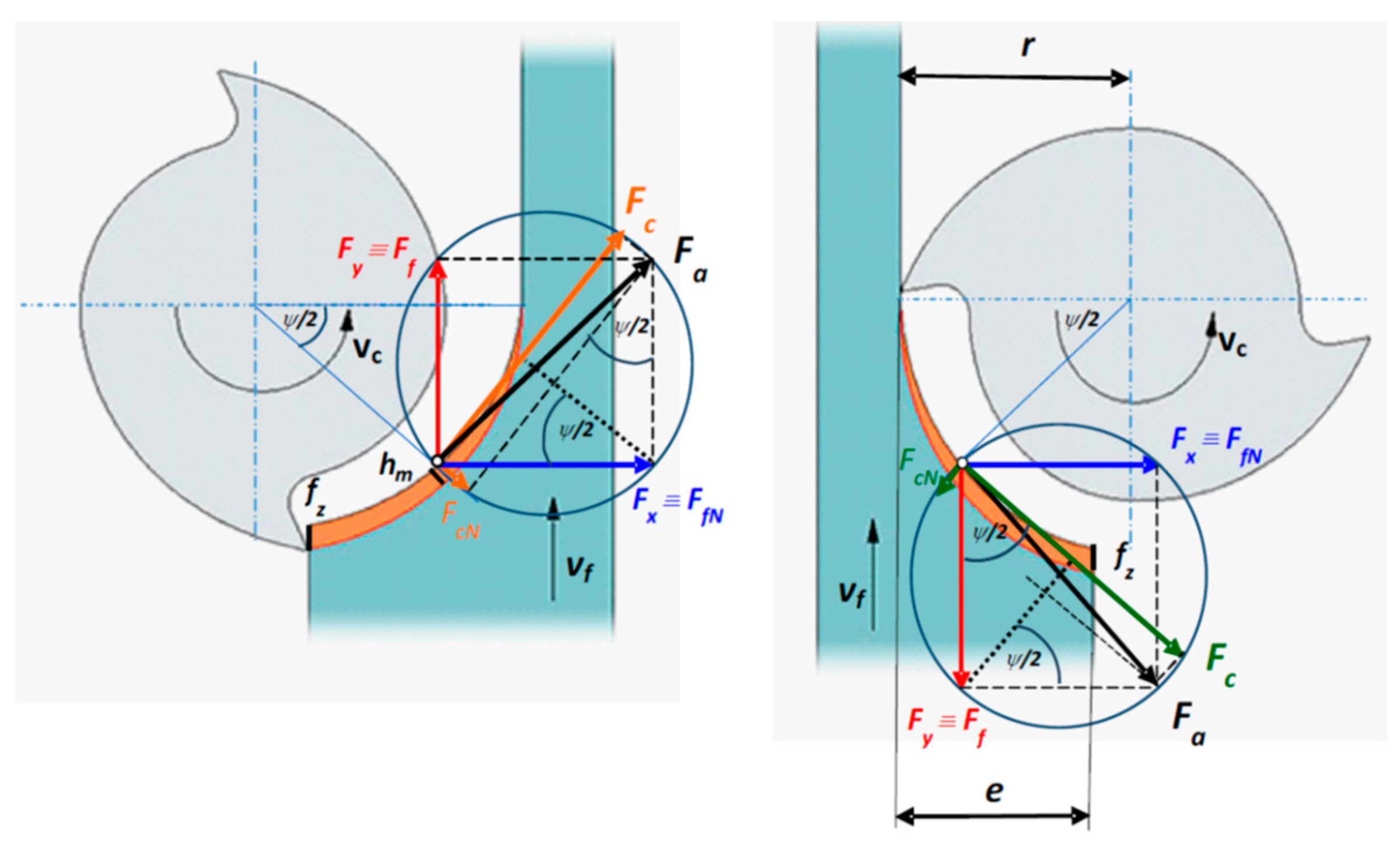
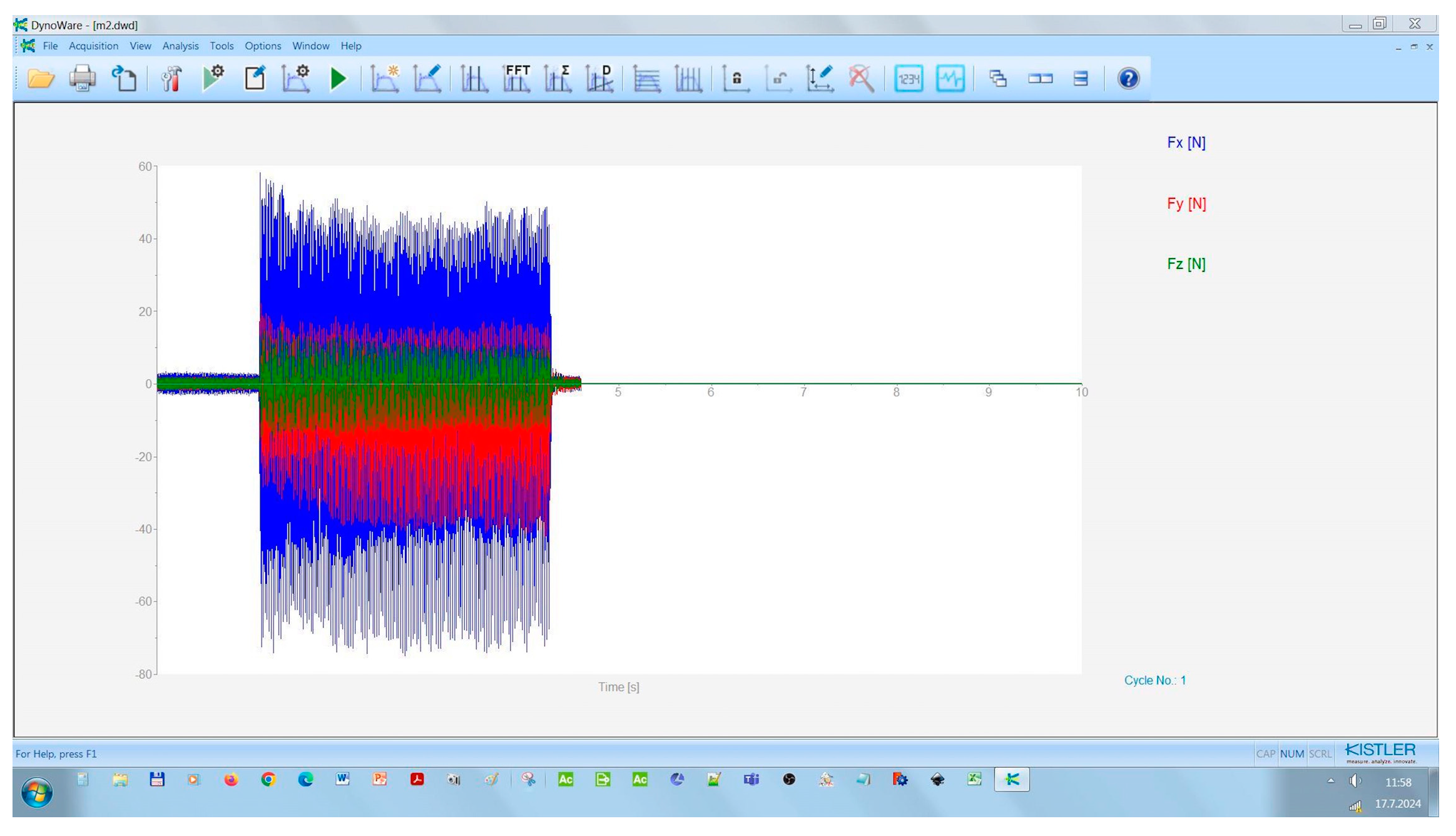
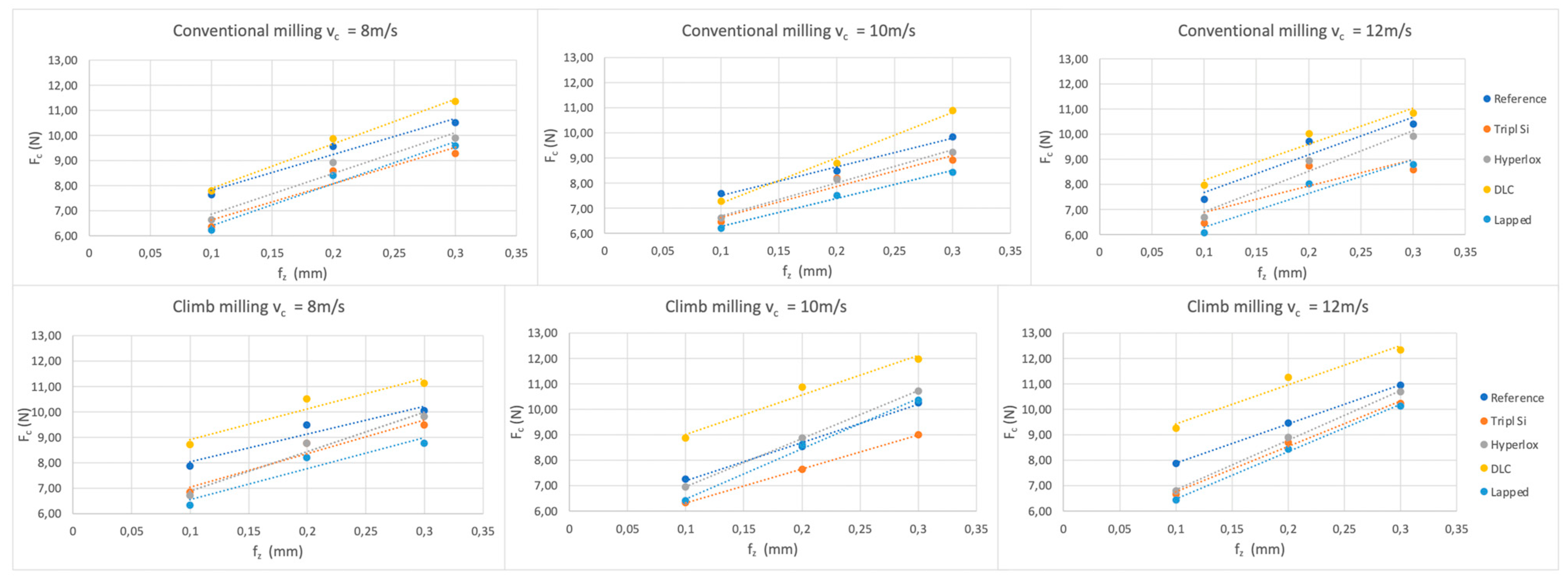
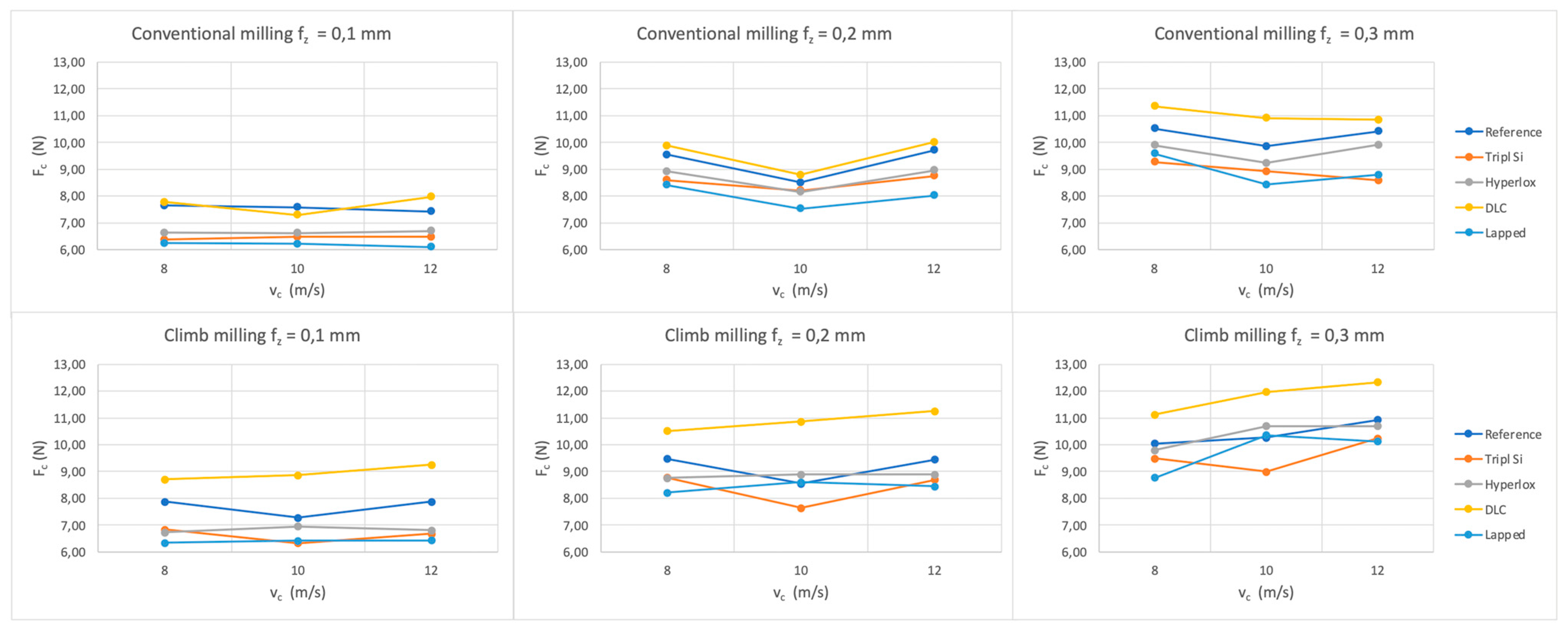
| Structure | Binder: 10 % Density: 14.38 g/cm3 KIC: 0.4 MPa⋅m1/2 |
| Grain size | Submicron |
| Hardness | HV30: 1600 HRA: 91.9 |
| Transverse rupture strength | 4000 MPa 580,150 psi |
| Tool Diameter | 10 mm |  | Lapped TripleSi DLC Hyperlox Reference |
| Tool Length | 80 mm | ||
| Number of Teeth | 1 | ||
| Tool Geometry | Rake angle 5° Clearance angle 20° Cutting edge angle 65° |
| Cutting Speed vc (m/s) | 8 | 10 | 12 | ||||||
| Rotation of Cutter n (ot/min) | 15,287 | 19,108 | 22,930 | ||||||
| Feed Per Tooth fz (mm) | 0.1 | 0.2 | 0.3 | 0.1 | 0.2 | 0.3 | 0.1 | 0.2 | 0.3 |
| Depth of Cut e (mm) | 1 mm | ||||||||
| Type of Milling | Conventional/Climb | ||||||||
| vc (m/s) | 8 | 10 | 12 | ||||||||
|---|---|---|---|---|---|---|---|---|---|---|---|
| fz (mm) | 0.1 | 0.2 | 0.3 | 0.1 | 0.2 | 0.3 | 0.1 | 0.2 | 0.3 | ||
| Reference | 7.65 | 9.55 | 10.52 | 7.59 | 8.50 | 9.85 | 7.43 | 9.72 | 10.42 | 9.03 | 0% |
| TripleSi | 6.38 | 8.60 | 9.28 | 6.48 | 8.21 | 8.93 | 6.48 | 8.76 | 8.59 | 7.97 | −12% |
| Hyperlox | 6.64 | 8.92 | 9.90 | 6.62 | 8.16 | 9.24 | 6.70 | 8.96 | 9.92 | 8.34 | −8% |
| DLC | 7.79 | 9.88 | 11.35 | 7.30 | 8.79 | 10.91 | 7.98 | 10.02 | 10.84 | 9.25 | 2% |
| Lapped | 6.24 | 8.42 | 9.59 | 6.22 | 7.53 | 8.43 | 6.10 | 8.03 | 8.79 | 7.71 | −15% |
| 6.94 | 9.07 | 10.13 | 6.84 | 8.24 | 9.47 | 6.94 | 9.10 | 9.71 | Average values | Percentual comparison | |
| vc (m/s) | 8 | 10 | 12 | ||||||||
|---|---|---|---|---|---|---|---|---|---|---|---|
| fz (mm) | 0.1 | 0.2 | 0.3 | 0.1 | 0.2 | 0.3 | 0.1 | 0.2 | 0.3 | ||
| Reference | 7.88 | 9.48 | 10.05 | 7.27 | 8.55 | 10.26 | 7.87 | 9.45 | 10.93 | 9.08 | 0 % |
| TripleSi | 6.84 | 8.77 | 9.48 | 6.33 | 7.64 | 8.99 | 6.68 | 8.70 | 10.23 | 8.19 | −10% |
| Hyperlox | 6.73 | 8.76 | 9.80 | 6.96 | 8.88 | 10.70 | 6.80 | 8.88 | 10.69 | 8.69 | −4% |
| DLC | 8.71 | 10.51 | 11.12 | 8.87 | 10.86 | 11.97 | 9.25 | 11.26 | 12.33 | 10.54 | 16% |
| Lapped | 6.33 | 8.22 | 8.77 | 6.41 | 8.60 | 10.35 | 6.43 | 8.45 | 10.13 | 8.19 | −10% |
| 7.30 | 9.15 | 9.84 | 7.17 | 8.91 | 10.46 | 7.41 | 9.35 | 10.86 | Average values | Percentual comparison | |
| Conventional Milling | 0.1 | 0.2 | 0.3 | Climb Milling | 0.1 | 0.2 | 0.3 | ||
|---|---|---|---|---|---|---|---|---|---|
| 6.905 | 8.803 | 9.770 | 7.289 | 9.133 | 10.387 | ||||
| 0.1 | 6.905 | 0 | 46.212 | 105.368 | 0.1 | 7.289 | 0 | 25.947 | 73.255 |
| 0.2 | 8.803 | 46.212 | 0 | 12.019 | 0.2 | 9.133 | 25.947 | 0 | 12.006 |
| 0.3 | 9.770 | 105.368 | 12.019 | 0 | 0.3 | 10.387 | 73.255 | 12.006 | 0 |
| KH | 6.439 | KH | 6.439 | ||||||
| SUMMARY Conventional Milling | ||||
|---|---|---|---|---|
| Groups | Count | Sum | Average | Variance |
| vc = 8 m/s | 15 | 130.708546 | 8.7139031 | 2.34239037 |
| vc = 10 m/s | 15 | 122.762359 | 8.18415729 | 1.65700869 |
| vc = 12 m/s | 15 | 128.728534 | 8.58190225 | 2.14148394 |
| ANOVA | ||||||
|---|---|---|---|---|---|---|
| Source of Variation | SS | df | MS | F | p-value | F crit |
| Between Groups | 2.28127945 | 2 | 1.14063972 | 0.55723569 | 0.57696666 | 3.21994229 |
| Within Groups | 85.972362 | 42 | 2.046961 | |||
| Total | 88.2536415 | 44 |
| SUMMARY Climb Milling | ||||
|---|---|---|---|---|
| Groups | Count | Sum | Average | Variance |
| vc = 8 m/s | 15 | 131.434043 | 8.76226955 | 1.94361455 |
| vc = 10 m/s | 15 | 132.641947 | 8.84279648 | 2.96297326 |
| vc = 12 m/s | 15 | 138.078535 | 9.20523567 | 3.12564514 |
| ANOVA | ||||||
|---|---|---|---|---|---|---|
| Source of Variation | SS | df | MS | F | p-value | F crit |
| Between Groups | 1.67032868 | 2 | 0.83516434 | 0.31192982 | 0.7337141 | 3.21994229 |
| Within Groups | 112.451261 | 42 | 2.67741098 | |||
| Total | 114.12159 | 44 |
| All Coatings | Reference | TripleSi | Hyperlox | DLC | Lapped | |
|---|---|---|---|---|---|---|
| 9.054 | 8.075 | 8.515 | 9.985 | 7.947 | ||
| Reference | 9.054 | 0 | 4.672 | 1.416 | 4.231 | 5.970 |
| TripleSi | 8.075 | 4.672 | 0 | 0.943 | 17.797 | 0.079 |
| Hyperlox | 8.515 | 1.416 | 0.943 | 0 | 10.545 | 1.570 |
| DLC | 9.985 | 4.231 | 17.797 | 10,545 | 0 | 20.255 |
| Lapped | 7.947 | 5.970 | 0.079 | 1.570 | 20.255 | 0 |
| KH | 4.958 | |||||
Disclaimer/Publisher’s Note: The statements, opinions and data contained in all publications are solely those of the individual author(s) and contributor(s) and not of MDPI and/or the editor(s). MDPI and/or the editor(s) disclaim responsibility for any injury to people or property resulting from any ideas, methods, instructions or products referred to in the content. |
© 2024 by the authors. Licensee MDPI, Basel, Switzerland. This article is an open access article distributed under the terms and conditions of the Creative Commons Attribution (CC BY) license (https://creativecommons.org/licenses/by/4.0/).
Share and Cite
Hanincová, L.; Procházka, J.; Novák, V. Comparative Analysis of Cutting Forces in CNC Milling of MDF: The Role of Tool Coatings, Cutting Speed, and Feed Per Tooth. Coatings 2024, 14, 1085. https://doi.org/10.3390/coatings14091085
Hanincová L, Procházka J, Novák V. Comparative Analysis of Cutting Forces in CNC Milling of MDF: The Role of Tool Coatings, Cutting Speed, and Feed Per Tooth. Coatings. 2024; 14(9):1085. https://doi.org/10.3390/coatings14091085
Chicago/Turabian StyleHanincová, Luďka, Jiří Procházka, and Vít Novák. 2024. "Comparative Analysis of Cutting Forces in CNC Milling of MDF: The Role of Tool Coatings, Cutting Speed, and Feed Per Tooth" Coatings 14, no. 9: 1085. https://doi.org/10.3390/coatings14091085






